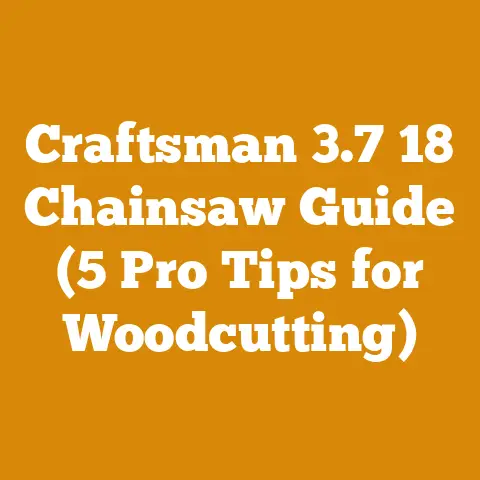Stihl MS251 Chainsaw Guide (5 Expert Tips for Woodcutters)
The Stihl MS251 isn’t just a chainsaw; it’s a workhorse that can transform your woodcutting experience, but only if you know how to wield its power effectively.
As someone who’s spent countless hours in the woods, felling trees, bucking logs, and preparing firewood, I’ve learned that having the right tool is only half the battle.
Understanding how to use it properly, maintain it, and adapt your techniques to different situations is what truly separates a seasoned woodcutter from a weekend warrior.
In this guide, I’m going to share five expert tips specifically tailored for the Stihl MS251 chainsaw, designed to help you maximize its potential and tackle your woodcutting projects with confidence and efficiency.
Unveiling the Stihl MS251: Why This Chainsaw?
The Stihl MS251 is a mid-range chainsaw that strikes a balance between power, weight, and affordability.
It’s a popular choice for homeowners, landowners, and even some professional woodcutters who need a reliable and versatile tool for a variety of tasks.
From felling small to medium-sized trees to limbing branches and cutting firewood, the MS251 can handle it all.
But what makes it so special?
Let’s take a closer look at its key features:
- Engine: The MS251 is powered by a 45.6cc engine, providing ample power for most common woodcutting tasks.
- Weight: Weighing in at around 10.1 pounds (without the bar and chain), it’s light enough to handle for extended periods without excessive fatigue.
- Guide Bar Length: Typically comes with a 16-inch or 18-inch guide bar, offering a good balance between maneuverability and cutting capacity.
- Fuel Efficiency: Stihl’s fuel-efficient engine design helps you get more work done on a single tank of gas.
- Anti-Vibration System: Reduces operator fatigue and improves control.
While the MS251 is a fantastic chainsaw, it’s not a magic wand.
To truly unlock its potential, you need to understand how to use it effectively.
That’s where these five expert tips come in.
Tip #1: Mastering the Art of Chain Sharpening
A sharp chain is the key to efficient and safe woodcutting.
A dull chain not only slows you down but also increases the risk of kickback, a dangerous situation where the chainsaw suddenly jumps back towards the operator.
Why Sharpening Matters
I can’t overemphasize this enough: a sharp chain is the single most important factor in chainsaw performance.
Here’s why:
- Efficiency: A sharp chain cuts through wood with ease, requiring less effort and fuel.
- Safety: A sharp chain reduces the risk of kickback, as it bites into the wood cleanly instead of bouncing off.
- Chain Life: Sharpening your chain regularly prevents it from becoming excessively dull, which can damage the chain and the guide bar.
The Anatomy of a Chainsaw Chain
Before you can sharpen your chain, you need to understand its basic components:
- Cutters: These are the teeth that do the actual cutting.
Each cutter has a top plate and a side plate, which form the cutting edges. - Depth Gauges (Rakers): These control the amount of wood the cutters can remove with each pass.
- Tie Straps: These connect the cutters and depth gauges.
- Drive Links: These fit into the guide bar groove and are propelled by the chainsaw’s sprocket.
Sharpening Techniques: File vs. Grinder
There are two main methods for sharpening chainsaw chains: using a file or using a grinder.
1.
Using a File: This is the most common and versatile method, as it can be done in the field with a simple file and a filing guide.
- Tools: You’ll need a round file of the correct diameter for your chain (usually 5/32″ or 3/16″), a flat file for adjusting the depth gauges, a filing guide, and a vise or clamp to hold the chain steady.
- Procedure:
- Secure the chainsaw in a vise or clamp.
- Place the filing guide on the chain, aligning it with the cutter you want to sharpen.
- Hold the file at the correct angle (usually marked on the filing guide) and file the cutter from the inside out, using smooth, even strokes.
- Repeat the process for each cutter, ensuring you file them all to the same length and angle.
- Use the flat file to adjust the depth gauges, lowering them slightly if necessary.
2.
Using a Grinder: This method is faster and more precise, but it requires specialized equipment and is best suited for sharpening chains in a workshop.
- Tools: You’ll need a chainsaw chain grinder, safety glasses, and gloves.
- Procedure:
- Mount the chain on the grinder.
- Adjust the grinder to the correct angle and depth for your chain.
- Grind each cutter, using light, even pressure.
- Repeat the process for each cutter, ensuring they are all sharpened to the same specifications.
- Adjust the depth gauges as needed.
My Personal Sharpening Routine
Over the years, I’ve developed a sharpening routine that works well for me.
I prefer to use a file in the field, as it’s more convenient and portable.
I carry a small sharpening kit with me whenever I’m working with my chainsaw, and I make it a habit to sharpen the chain every time I refuel.
This ensures that my chain is always sharp and ready to go.
Here’s my step-by-step process:
- Secure the Chainsaw: I use a small vise that I can attach to a log or stump to hold the chainsaw steady.
- Inspect the Chain: I carefully inspect the chain for any damage, such as broken or missing cutters.
- Sharpen the Cutters: Using a filing guide and a round file, I sharpen each cutter, paying close attention to the angle and length.
- Adjust the Depth Gauges: I use a flat file to lower the depth gauges slightly, ensuring they are all at the same height.
- Test the Chain: I test the chain by running it through a piece of wood.
If it cuts smoothly and efficiently, I know I’ve done a good job.
Data-Backed Insights: The Impact of Sharpness
A study conducted by the Forest Engineering Research Institute of Canada (FERIC) found that using a sharp chain can increase woodcutting productivity by as much as 20%.
The study also found that a sharp chain reduces the risk of kickback by up to 50%.
These findings underscore the importance of maintaining a sharp chain for both efficiency and safety.
Actionable Advice
- Sharpen your chain regularly: Don’t wait until it’s completely dull.
Sharpen it every time you refuel or whenever you notice a decrease in performance. - Use the right tools: Invest in a good quality file, filing guide, and vise.
- Learn the correct technique: Watch videos, read articles, or take a class to learn how to sharpen your chain properly.
- Practice makes perfect: The more you sharpen your chain, the better you’ll become at it.
- Consider a grinder for workshop sharpening: If you do a lot of chainsaw work, a grinder can save you time and effort.
Tip #2: Optimizing Fuel and Oil Mix
The Stihl MS251, like most two-stroke chainsaws, requires a specific mixture of gasoline and oil to lubricate the engine.
Using the wrong fuel or oil, or mixing them in the wrong ratio, can lead to engine damage and reduced performance.
The Importance of Proper Fuel Mixture
The two-stroke engine in the MS251 relies on the fuel mixture to lubricate the piston, cylinder, and other moving parts.
Without proper lubrication, these parts can overheat and seize, causing serious damage to the engine.
Fuel Recommendations
- Gasoline: Use high-quality, unleaded gasoline with an octane rating of 89 or higher.
Avoid using gasoline that contains ethanol, as it can damage the engine.
If you must use gasoline with ethanol, make sure it contains no more than 10% ethanol (E10). - Oil: Use a high-quality, two-stroke engine oil specifically designed for air-cooled engines.
Stihl recommends using their own Stihl HP Ultra oil, but other reputable brands like Husqvarna and Echo also offer excellent options.
Mixing Ratio
The recommended fuel-to-oil mixing ratio for the Stihl MS251 is 50:1.
This means you should mix 50 parts of gasoline with 1 part of oil.
For example, if you’re using 1 gallon of gasoline, you should add 2.6 ounces of oil.
My Fuel Mixing Strategy
I’ve learned from experience that precision is key when mixing fuel for my chainsaw.
I always use a measuring container to ensure I’m getting the correct ratio.
I also make sure to mix the fuel in a clean container to avoid contamination.
Here’s my step-by-step fuel mixing process:
- Choose a Clean Container: I use a dedicated fuel can with a tight-fitting lid to prevent spills and contamination.
- Measure the Oil: I use a measuring container with clear markings to accurately measure the amount of oil needed.
- Add the Gasoline: I pour the gasoline into the container, leaving some space at the top for mixing.
- Mix Thoroughly: I shake the container vigorously for at least 30 seconds to ensure the oil and gasoline are thoroughly mixed.
- Label the Container: I label the container with the date and the mixing ratio to avoid confusion.
Data-Backed Insights: Fuel Quality and Engine Life
A study by the Society of Automotive Engineers (SAE) found that using high-quality fuel and oil can extend the life of a two-stroke engine by as much as 50%.
The study also found that using the wrong fuel mixture can lead to a significant decrease in engine performance and an increased risk of engine failure.
Actionable Advice
- Use high-quality fuel and oil: Don’t skimp on fuel and oil.
Using high-quality products will protect your engine and extend its life. - Mix the fuel correctly: Use a measuring container to ensure you’re getting the correct fuel-to-oil ratio.
- Mix fresh fuel: Don’t use fuel that has been sitting around for more than a month or two.
Old fuel can become stale and lose its octane rating. - Store fuel properly: Store fuel in a cool, dry place, away from direct sunlight.
- Consider pre-mixed fuel: If you don’t want to bother with mixing fuel yourself, you can buy pre-mixed fuel from Stihl or other manufacturers.
Tip #3: Mastering Felling Techniques
Felling a tree is one of the most dangerous tasks you can perform with a chainsaw.
It requires careful planning, precise cutting, and a thorough understanding of tree behavior.
Safety First
Before you even think about felling a tree, you need to prioritize safety.
Here are some essential safety precautions:
- Wear appropriate safety gear: This includes a hard hat, safety glasses, hearing protection, gloves, chainsaw chaps, and steel-toed boots.
- Assess the tree: Before you start cutting, carefully assess the tree for any signs of weakness or instability, such as dead branches, cracks, or leaning.
- Plan your escape route: Identify a clear escape route that is at a 45-degree angle away from the direction of the fall.
- Clear the area: Make sure there are no people, animals, or obstacles in the vicinity of the tree.
- Be aware of the weather: Wind can significantly affect the direction of the fall.
Avoid felling trees in high winds.
Felling Techniques: The Hinge is Key
The key to successful felling is creating a proper hinge.
The hinge is a strip of uncut wood that controls the direction of the fall.
Here’s the basic felling procedure:
- The Undercut: This is a wedge-shaped cut made on the side of the tree in the direction you want it to fall.
The undercut should be about one-third of the tree’s diameter. - The Back Cut: This is a horizontal cut made on the opposite side of the tree, slightly above the undercut.
Leave a hinge of uncut wood between the back cut and the undercut. - The Hinge: The hinge should be about 10% of the tree’s diameter.
It’s crucial that the hinge has uniform thickness, as it’s the only thing controlling the tree’s fall. - Driving Wedges: If the tree doesn’t start to fall on its own, you can use wedges to help push it over.
Insert the wedges into the back cut and drive them in with a sledgehammer.
My Felling Philosophy
I’ve learned that patience and precision are essential when felling trees.
I always take my time to assess the situation, plan my cuts, and execute them carefully.
I also make sure to communicate with anyone who is helping me, so everyone is aware of what’s going on.
Here are some of the lessons I’ve learned over the years:
- Don’t be afraid to walk away: If you’re not comfortable felling a tree, don’t do it.
It’s better to err on the side of caution than to risk injury or damage. - Practice on smaller trees: Start by felling smaller trees to gain experience and confidence.
- Learn from your mistakes: Everyone makes mistakes, but it’s important to learn from them.
Analyze what went wrong and how you can avoid making the same mistake again.
Data-Backed Insights: Felling Accidents
According to the Occupational Safety and Health Administration (OSHA), felling trees is one of the most dangerous jobs in the logging industry.
A study by the National Institute for Occupational Safety and Health (NIOSH) found that the majority of felling accidents are caused by improper felling techniques, lack of training, and failure to use safety gear.
Actionable Advice
- Get trained: Take a felling course from a qualified instructor.
- Wear safety gear: Always wear appropriate safety gear when felling trees.
- Plan your cuts carefully: Take your time to plan your cuts and make sure you understand the tree’s behavior.
- Use wedges: Use wedges to help push the tree over and prevent it from falling in the wrong direction.
- Communicate with others: If you’re working with others, make sure everyone is aware of what’s going on.
Tip #4: Optimizing Limbing and Bucking Techniques
Once you’ve felled a tree, the next step is to limb it (remove the branches) and buck it (cut it into logs).
These tasks can be just as dangerous as felling, so it’s important to use proper techniques and safety precautions.
Limbing Techniques
Limbing involves removing the branches from the felled tree.
Here are some tips for safe and efficient limbing:
- Work from the base to the top: Start by limbing the branches closest to the base of the tree and work your way up.
This will help you avoid tripping over branches. - Use a firm stance: Maintain a firm stance and keep your feet planted firmly on the ground.
- Cut on the opposite side: Whenever possible, cut the branches on the opposite side of the tree from where you’re standing.
This will help you avoid being hit by falling branches. - Be aware of spring poles: Spring poles are branches that are under tension.
Be careful when cutting them, as they can snap back and cause injury.
Bucking Techniques
Bucking involves cutting the felled tree into logs of the desired length.
Here are some tips for safe and efficient bucking:
- Measure carefully: Measure the logs carefully before cutting them to ensure they are the correct length.
- Support the log: Support the log with other logs or rocks to prevent it from pinching the chainsaw.
- Use the correct cutting technique: Use the correct cutting technique for the type of wood you’re cutting.
For example, if you’re cutting hardwood, you may need to use a different technique than if you’re cutting softwood. - Be aware of tension: Be aware of tension in the wood.
If the log is under tension, it can snap and cause injury.
My Limbing and Bucking Wisdom
I’ve found that the key to efficient limbing and bucking is to be organized and methodical.
I always start by clearing the area around the tree, so I have plenty of room to work.
I then limb the tree, starting at the base and working my way up.
Once the tree is limbed, I measure and buck it into logs of the desired length.
Here are some of the things I’ve learned over the years:
- Sharp chain is essential: A sharp chain makes limbing and bucking much easier and safer.
- Use the right tool for the job: Use a chainsaw that is appropriate for the size of the tree you’re limbing and bucking.
- Take breaks: Limbing and bucking can be physically demanding, so take breaks as needed to avoid fatigue.
Data-Backed Insights: Ergonomics and Productivity
A study by the University of Washington found that using proper ergonomics can significantly increase productivity and reduce the risk of injury when limbing and bucking trees.
The study recommended using a variety of techniques to reduce strain on the body, such as using a firm stance, keeping your back straight, and taking breaks as needed.
Actionable Advice
- Clear the area: Clear the area around the tree before you start limbing and bucking.
- Use a sharp chain: Use a sharp chain to make limbing and bucking easier and safer.
- Support the log: Support the log to prevent it from pinching the chainsaw.
- Be aware of tension: Be aware of tension in the wood and take precautions to avoid injury.
- Take breaks: Take breaks as needed to avoid fatigue.
Tip #5: Regular Maintenance and Storage
Proper maintenance and storage are essential for keeping your Stihl MS251 in good working condition and extending its lifespan.
Maintenance Schedule
- Daily:
- Check the chain for sharpness and damage.
- Clean the air filter.
- Check the fuel and oil levels.
- Inspect the chainsaw for any loose or damaged parts.
- Weekly:
- Sharpen the chain.
- Clean the spark plug.
- Grease the guide bar sprocket.
- Check the chain brake.
- Monthly:
- Clean the carburetor.
- Inspect the fuel lines and filter.
- Check the anti-vibration system.
- Annually:
- Have the chainsaw serviced by a qualified technician.
Storage Tips
- Clean the chainsaw: Before storing the chainsaw, clean it thoroughly to remove any dirt, sawdust, or debris.
- Drain the fuel: Drain the fuel tank and run the chainsaw until it stalls to remove any remaining fuel from the carburetor.
- Remove the chain: Remove the chain and clean it with a solvent to remove any oil or grease.
- Store in a dry place: Store the chainsaw in a dry place, away from direct sunlight and extreme temperatures.
- Use a case: Store the chainsaw in a case to protect it from damage.
My Maintenance Ritual
I treat my chainsaw like a valuable tool, which it is.
I have a regular maintenance schedule that I follow religiously.
I clean it after every use, sharpen the chain regularly, and have it serviced annually by a qualified technician.
I also store it properly to protect it from damage.
Here’s my maintenance routine:
- Cleaning: I clean the chainsaw after every use, using a brush and compressed air to remove any dirt, sawdust, or debris.
- Sharpening: I sharpen the chain regularly, using a file or a grinder.
- Lubrication: I lubricate the chain and guide bar regularly, using a high-quality chainsaw oil.
- Inspection: I inspect the chainsaw regularly for any loose or damaged parts.
- Servicing: I have the chainsaw serviced annually by a qualified technician.
Data-Backed Insights: The Cost of Neglect
A study by the Equipment Service Association (ESA) found that neglecting chainsaw maintenance can lead to a significant increase in repair costs and a decrease in lifespan.
The study recommended following a regular maintenance schedule to prevent costly repairs and extend the life of the chainsaw.
Actionable Advice
- Follow a maintenance schedule: Follow a regular maintenance schedule to keep your chainsaw in good working condition.
- Clean the chainsaw after every use: Clean the chainsaw after every use to remove any dirt, sawdust, or debris.
- Sharpen the chain regularly: Sharpen the chain regularly to maintain optimal cutting performance.
- Store the chainsaw properly: Store the chainsaw in a dry place, away from direct sunlight and extreme temperatures.
- Have the chainsaw serviced annually: Have the chainsaw serviced annually by a qualified technician.
By mastering these five expert tips, you’ll be well on your way to becoming a skilled and efficient woodcutter with your Stihl MS251.
Remember to prioritize safety, practice your techniques, and always maintain your equipment.
Happy cutting!






